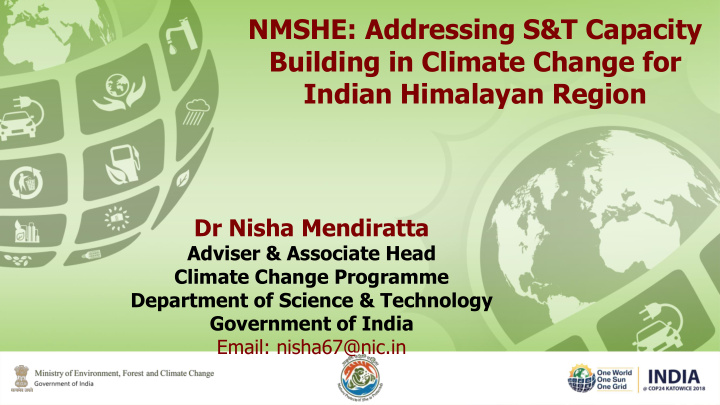



NMSHE: Addressing S&T Capacity Building in Climate Change for Indian Himalayan Region Dr Nisha Mendiratta Adviser & Associate Head Climate Change Programme Department of Science & Technology Government of India Email: nisha67@nic.in
Broad Objectives of NMSHE The primary objective of the mission is to build S&T Capacity to address sustenance of Himalayan ecosystem. To achieve above, the mission aims to - Understand the complex processes affecting Himalayan Eco system and evolve suitable management and policy measures for sustaining and safeguarding the Himalayan Eco system Assess the health status of the Himalayan ecosystem for policy- formulation functions Assist states in the Indian Himalayan Region (IHR) for implementation of actions selected for sustainable development
Major Programmes/Projects Launched under NMSHE A Centre of Glaciology at Wadia Institute of Himalayan Geology, Dehradun 6 Thematic Task Forces anchored around 6 lead institutions State CC Centres in 11 out of 12 Himalayan States Inter-University Consortium of 4 universities Indo-Swiss Capacity Building Programme in glaciology and related areas
6 Thematic Task Forces Anchored Around Existing Lead R&D Institutions in the Himalayan Region 6 Thematic Task forces set up at 6 lead institutions working in the areas of Himalayan Ecosystem Task Forces scientifically support the NMSHE objectives to develop a national capacity to continuously assess the health status of the Himalayan ecosystem The Task Forces has engaged more than 100 research teams so far from more than 60 research and academic institutions spread across the IHR along with the state governments of the 12 Himalayan states .
Institutions Leading 6 Thematic Task Forces Wadia Institute of Himalayan Natural & geological wealth 1 Geology National Institute of Hydrology Water, ice, snow, including glaciers 2 Wildlife Institute of India Micro flora & fauna, wildlife & animal 3 population GB Pant National Institute of Forest resources & plant biodiversity 4 Himalayan Environment and Sustainable Development Indian Council of Agriculture Himalayan Agriculture 5 Research Jawaharlal Nehru University Traditional Knowledge 6
Assigned Task to Thematic Task Forces Establishing Database Designing Monitoring systems Modeling and Simulation Vulnerability Assessment Adaptation policy Research Pilot Studies for Revalidation
State CC Cells in the Indian Himalayan Region 1 J&K 7 Mizoram 2 HP 8 Nagaland 3 Uttarakhand 9 Sikkim 4 Arunachal Pradesh 10 Tripura 5 Manipur 11 West Bengal 6 Meghalaya
Assigned Tasks to State CC Cells Vulnerability & Risk and Hazards Assessment at district and sub-district levels Development and implementation of training programmes Public Awareness Programmes and Institutional Capacity Building initiatives
Assistance Provided to State CC Cells (Supported by IHCAP/SDC ) Scoping Studies and development of a Vulnerability framework & Risk Assessment (led by IISc, Bangalore) Training of Development of Training Modules and Training of Trainers Stakeholders (led by NABCONS) Public Awareness Media Workshops and Training (led by CMS) Institutional Linkages with State and National level Institutions Capacity Building (TFs, National/State Insti, Univ)
Indo-Swiss Capacity Building Programme in Glaciology As part of S&T Agreement between India and Switzerland, an Indo-Swiss bilateral programme was developed during 2012 with the main mandate to build capacity in the field of Glaciology & related areas in climate change. Under this programme, 55 students were trained by Indian and Swiss experts through a three level training programme. Swiss Agency for Development and Cooperation (SDC) through its Indian Himalayan Climate Adaptation Programme (IHCAP) is partnering with NMSHE to assist 12 Himalayan states in implementing tasks assigned to them as part of support provided by DST to State CC Cells
NMSHE: Impacts and Benefits to the Society National Himalayan Health Status Report from 6 Task Forces will help assessing the health of IHR for initiating necessary scientific evidence based policy intervention for long term sustenance of Himalayan region. The Mission created a network of nearly 150 institutions and 250 scientists within and outside IHR Mission developed human capacity in terms 70 PhD and PG students. State CC Centres conducted 75 training programmes wherein over 10000 personnel trained Mission supported 15 national level events wherein over 500 participants benefited
Concluding Remarks National Mission for Sustaining the Himalayan Ecosystem has made considerable progress A detailed Pan-Himalayan health status report is being brought out shortly covering aspects like glaciology, hydrology, meteorology, forestry, flora/fauna, agriculture and traditional knowledge system. DST has built a strong partnership with Swiss Agency for Development and Cooperation (SDC) which is expected strengthen in the times to come A detailed Vulnerability & Risk assessment exercise has been carried out with the active participation of 12 Himalayan States
Thanks !!
Recommend
More recommend